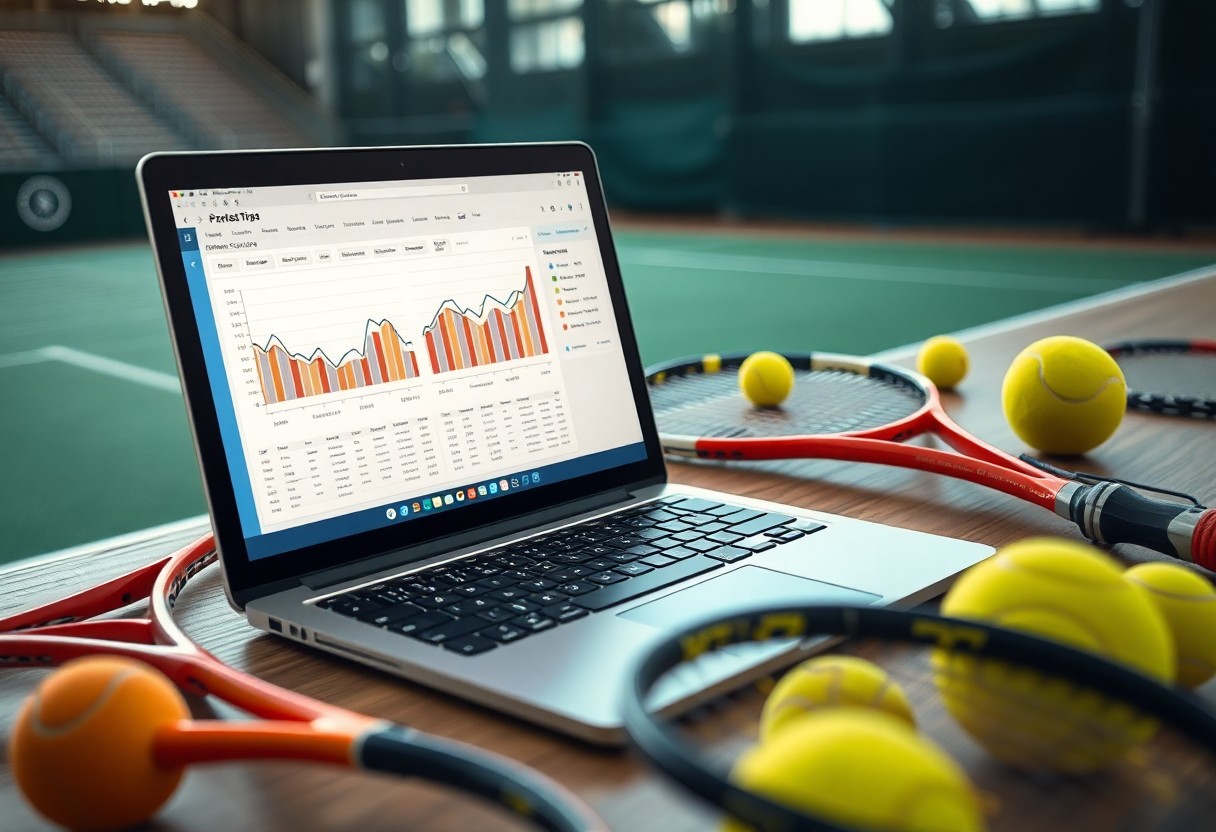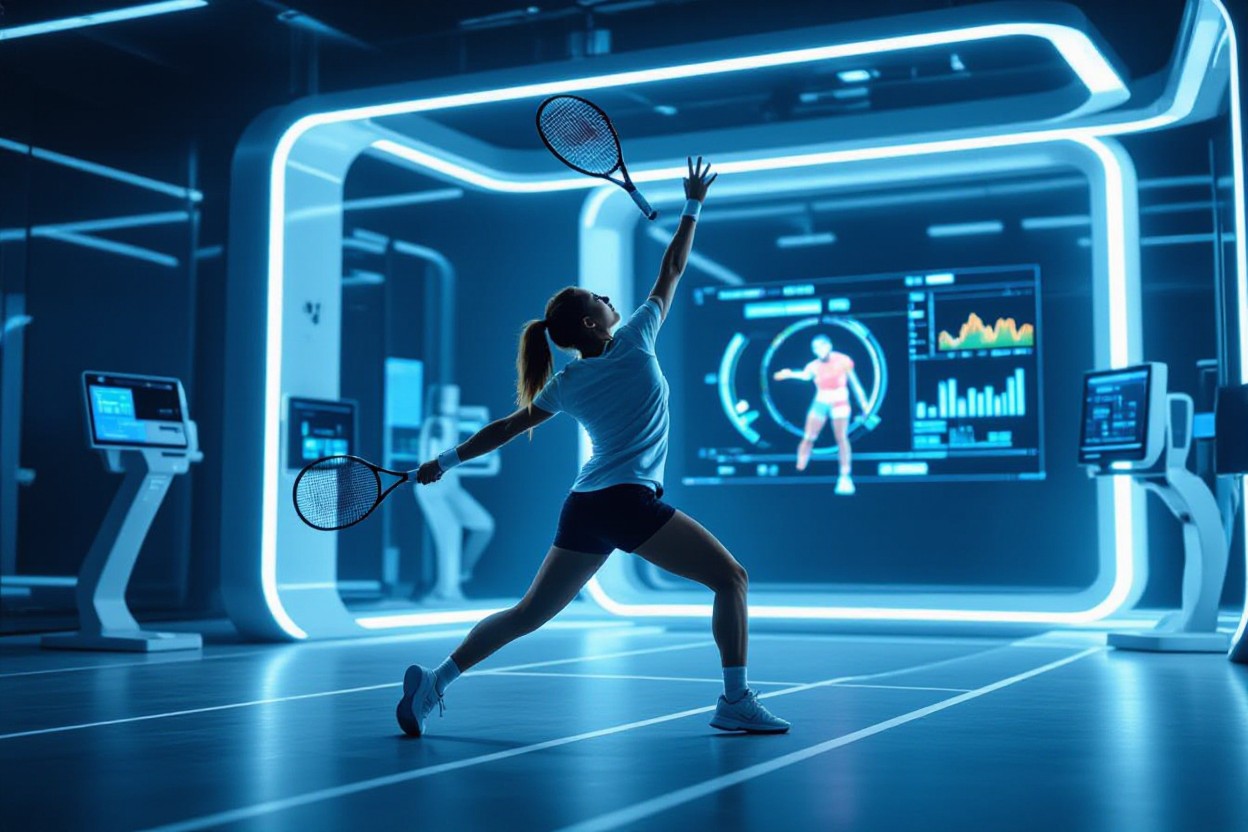It’s impossible to ignore how revolutionary technology is transforming your tennis experience at every level of the game. From Hawk-Eye’s precision line-calling that eliminates human error to advanced racquet materials that enhance your power and control, technology is reshaping how you play, watch, and understand tennis. Real-time analytics now provide you with unprecedented insights into player performance, while smart courts and AI-powered coaching apps are making professional-level training accessible to recreational players like yourself. However, this technological surge raises concerns about preserving tennis’s traditional essence and whether we’re witnessing the dawn of a new golden age or potentially compromising the sport’s authentic character.
Game-Changing Innovations: How Technology is Reshaping Tennis
You’re witnessing a technological revolution that’s fundamentally altering how tennis is played, coached, and experienced. Professional players now generate over 3 million data points per match, while recreational players access tools once reserved for elite athletes. Smart courts equipped with computer vision track ball trajectories within millimeters, and AI-powered coaching apps provide real-time technique corrections. Your local tennis facility likely features automated line-calling systems that eliminate human error, while streaming platforms use predictive algorithms to enhance viewing experiences with instant statistics and player insights.
The Rise of Smart Rackets and Wearable Tech
Your racket can now measure swing speed, ball impact location, and spin rate with remarkable precision. Babolat’s Play racket captures 1,000 data points per second, while wearable sensors track your movement patterns, heart rate variability, and fatigue levels throughout matches. Professional players like Novak Djokovic use specialized wearables that monitor muscle activation and joint stress, allowing coaches to optimize training loads and prevent injuries. These devices sync seamlessly with mobile apps, giving you access to performance metrics that were impossible to obtain just five years ago.
Data Analytics: Transforming Player Performance
Your game strategy now relies on sophisticated analytics that reveal opponent weaknesses and optimize shot selection. TennisBot’s AI system analyzes over 15,000 professional matches annually, identifying patterns in serve placement, return positioning, and rally construction. Players receive detailed heat maps showing where they win and lose points, while coaches use predictive models to anticipate opponent tactics. This data-driven approach has revolutionized preparation methods, with top players spending hours studying algorithmic breakdowns of their upcoming opponents’ tendencies.
Professional tennis academies now employ dedicated data scientists who work alongside traditional coaches to maximize player development. The Spanish Tennis Federation’s analytics program increased junior player win rates by 23% over two seasons by identifying technical flaws through biomechanical analysis and shot pattern recognition. Your serve placement, for instance, can be optimized using machine learning algorithms that calculate optimal angles based on your height, arm length, and opponent positioning. Advanced video analysis breaks down your stroke mechanics frame by frame, comparing them to professional benchmarks and suggesting specific adjustments. College programs increasingly recruit players based on analytical profiles rather than traditional scouting, evaluating metrics like point construction efficiency and pressure-situation performance that weren’t measurable in tennis’s analog era.
Revolutionizing Training: The Role of Virtual Reality and AI
Virtual reality and artificial intelligence are fundamentally reshaping how you develop your tennis skills, offering personalized training experiences that adapt to your unique playing style and learning pace. Professional academies like the Rafa Nadal Academy have already integrated VR systems that allow you to practice against virtual opponents programmed with the exact playing patterns of top ATP and WTA players. Meanwhile, AI-powered coaching platforms analyze thousands of data points from your matches and practice sessions, identifying weaknesses in your game that even experienced human coaches might miss.
Immersive Learning Experiences: The Use of VR in Practice
VR headsets now transport you onto virtual courts where you can practice return of serve against Serena Williams’ exact serving patterns or work on your backhand against Novak Djokovic’s signature shots. Companies like Sense Arena have developed tennis-specific VR training that tracks your racquet movement with millimeter precision, allowing you to perfect your technique without needing a physical court. The technology records your reaction times, footwork patterns, and shot accuracy, providing instant feedback that accelerates your learning curve by up to 40% compared to traditional practice methods.
AI Coaching: Tailoring Strategies for Individual Players
AI coaching systems analyze your playing data to create customized training programs that evolve based on your progress and performance metrics. TennisBot, used by several professional players, processes video footage of your matches to identify tactical patterns and suggests specific drills to address your weaknesses. The system recognizes that your forehand tends to break down under pressure at 4-4 in the third set, or that you consistently struggle with wide serves to your backhand side.
These AI systems go beyond basic pattern recognition by incorporating biometric data, weather conditions, and opponent analysis to provide strategic recommendations. Professional player Matteo Berrettini credits AI analysis with helping him improve his net play by 23% during the 2023 season, after the system identified optimal approach shot opportunities based on his opponent’s court positioning. The technology tracks over 300 different variables during matches, from your heart rate variability to the spin rate of your shots, creating a comprehensive profile that human coaches use to fine-tune your tactical approach. Your AI coach never gets tired, never has off days, and can process match data from thousands of professional games to suggest the most effective strategies for your specific skill level and physical attributes.
Enhancing Spectator Engagement: Tech-Driven Viewing Experiences
Modern tennis broadcasts have transformed beyond simple camera coverage into interactive digital experiences that put you at the center of the action. Major tournaments now deploy over 40 cameras per court, including specialized ball-tracking systems and player-focused units that capture micro-expressions during crucial points. Real-time statistics overlay directly onto your screen, showing serve speeds, rally lengths, and predictive analytics that help you understand strategic decisions as they unfold. Tennis Channel’s recent integration of biometric data allows you to see players’ heart rates during match points, creating an unprecedented level of intimacy with professional competition.
Augmented Reality in Live Matches: Elevating Fan Interaction
AR applications now let you point your smartphone at any tennis court to access instant player statistics, shot trajectories, and tactical analysis overlaid directly onto the live action. Wimbledon’s 2023 AR experience allowed spectators to view historical match data from legendary encounters played on the same court decades earlier. Interactive heat maps show exactly where players are most vulnerable, while predictive algorithms suggest optimal shot placement in real-time, transforming casual viewers into tactical analysts during live matches.
Streaming Innovations: Changing How We Consume Tennis
Tennis streaming platforms have revolutionized viewing flexibility through multi-angle camera selection and personalized commentary tracks. Amazon Prime’s recent tennis coverage offers you the choice between traditional broadcast commentary, player-focused analysis, or tactical breakdowns from former professionals. Interactive features allow you to pause mid-rally to examine shot placement and access instant replays from any of six different camera angles, creating a completely customized viewing experience.
Streaming services are fundamentally reshaping tennis consumption patterns by offering comprehensive tournament packages that include practice sessions, player interviews, and behind-the-scenes content previously unavailable to general audiences. Tennis TV’s subscription model provides access to over 2,000 live matches annually, while ESPN+ integrates social features that let you share specific rally moments with friends instantly. Advanced algorithms now curate highlight reels based on your favorite players and playing styles, ensuring you never miss crucial moments even when following multiple tournaments simultaneously. The shift toward on-demand viewing has particularly benefited tennis fans across different time zones, with platforms offering condensed match versions that maintain narrative tension while reducing viewing time by 60-70%.
Ethical Considerations and the Future of Competition
You’re witnessing tennis grapple with questions that extend far beyond the baseline. Technology’s rapid integration raises fundamental concerns about competitive integrity, accessibility, and the sport’s core identity. Professional players now face scenarios where AI-powered coaching insights, real-time biometric monitoring, and advanced equipment materials create potential advantages that weren’t imaginable just a decade ago. The ATP and WTA are establishing new regulatory frameworks to address these challenges, but the pace of technological advancement often outstrips governing bodies’ ability to create comprehensive guidelines.
The Debate Around Fair Play in a Tech-Enhanced Environment
Your access to cutting-edge technology shouldn’t determine your competitive success, yet tennis increasingly faces this reality. Players from well-funded academies utilize $50,000 motion-capture systems and AI analysis tools, while others rely on basic video review. The French Open recently banned certain smart strings that provide real-time tension feedback, highlighting how governing bodies struggle to define where performance enhancement crosses into unfair advantage. This technological divide mirrors broader socioeconomic disparities in tennis, potentially widening the gap between elite and developing players.
Balancing Tradition with Innovation: Where Do We Draw the Line?
Tennis purists argue that excessive technology threatens the sport’s fundamental character – the mental fortitude, instinctive decision-making, and raw athletic ability that have defined champions for over a century. Wimbledon’s strict dress code and grass court tradition exemplify tennis’s reverence for heritage, yet the same tournament now employs sophisticated ball-tracking systems and electronic line calling. Your experience as a spectator and player hangs in the balance as tennis navigates between preserving its essence and embracing beneficial innovations.
Consider how Hawk-Eye transformed tennis by eliminating contentious line calls, yet some argue it removed the human drama of challenging officials. Similar debates now surround proposals for AI-assisted umpiring and automated coaching violations. The ITF’s recent approval of larger racquet head sizes for recreational play demonstrates one approach – allowing innovation at grassroots levels while maintaining stricter professional standards. However, this creates a concerning precedent where recreational and professional tennis could diverge significantly. Youth players developing with tech-enhanced training methods may struggle to adapt when facing restrictions at higher competitive levels, potentially stifling talent development and creating an uneven playing field across different tournament categories.
The Global Impact: Expanding Tennis Access through Technology
Technology has demolished traditional barriers that once limited tennis participation to affluent communities with established court infrastructure. Mobile coaching apps now reach players in remote villages across India, Africa, and South America, where professional instruction was previously unavailable. Virtual reality training systems allow aspiring players in urban apartments to practice technique without court access, while AI-powered video analysis provides instant feedback that rivals expensive private coaching. Your smartphone has become a gateway to world-class tennis education, regardless of your geographic location or economic circumstances.
Mobile Platforms and Accessibility for Aspiring Players
Smartphone applications have revolutionized how you can learn tennis fundamentals without traditional resources. Apps like TennisBot and CoachEye provide frame-by-frame swing analysis using just your phone’s camera, delivering personalized feedback that previously required expensive video equipment and professional expertise. These platforms offer multilingual support, making tennis instruction accessible to non-English speakers worldwide. Your practice sessions can now include augmented reality overlays showing optimal ball placement and movement patterns, transforming any flat surface into a virtual training ground.
Bridging Gaps: How Technology Affects Global Participation
Digital platforms are creating unprecedented opportunities for players from underserved regions to connect with global tennis networks. Online tournaments now feature participants from over 50 countries competing simultaneously, while virtual coaching exchanges pair experienced players with beginners across continents. Your ability to access professional-grade training content has become democratized through streaming platforms and interactive websites that cost a fraction of traditional lessons.
The transformation extends beyond individual skill development to community building and competitive opportunities. Tennis federations report a 340% increase in junior program registrations in developing nations since introducing mobile-first training initiatives. Countries like Kenya and Bangladesh have established national ranking systems entirely through digital platforms, allowing talented players to gain recognition without traveling to major tournaments. Your local tennis community can now tap into global expertise through virtual clinics led by former ATP and WTA professionals, while crowdfunding platforms enable promising players from economically disadvantaged backgrounds to secure equipment and training. Social media has created pathways for scouts to discover talent in previously overlooked regions, with several players from rural areas earning college scholarships after posting training videos online.
Conclusion
Taking this into account, you are witnessing tennis evolve at an unprecedented pace through technological integration. Your viewing experience has been transformed by advanced analytics, real-time data visualization, and enhanced broadcast capabilities, while players benefit from sophisticated training tools and performance monitoring systems. As you look ahead, the convergence of artificial intelligence, virtual reality, and biomechanical analysis suggests tennis is indeed entering a new golden age. Your engagement with the sport will continue to deepen as technology bridges the gap between professional excellence and fan accessibility, fundamentally reshaping how you experience and understand tennis.




